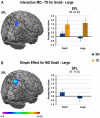Children with mathematical learning disability fail in recruiting verbal and numerical brain regions when solving simple multiplication problems
- PMID: 24858066
- PMCID: PMC4108534
- DOI: 10.1016/j.cortex.2014.04.001
Children with mathematical learning disability fail in recruiting verbal and numerical brain regions when solving simple multiplication problems
Abstract
Greater skill in solving single-digit multiplication problems requires a progressive shift from a reliance on numerical to verbal mechanisms over development. Children with mathematical learning disability (MD), however, are thought to suffer from a specific impairment in numerical mechanisms. Here we tested the hypothesis that this impairment might prevent MD children from transitioning toward verbal mechanisms when solving single-digit multiplication problems. Brain activations during multiplication problems were compared in MD and typically developing (TD) children (3rd to 7th graders) in numerical and verbal regions which were individuated by independent localizer tasks. We used small (e.g., 2 × 3) and large (e.g., 7 × 9) problems as these problems likely differ in their reliance on verbal versus numerical mechanisms. Results indicate that MD children have reduced activations in both the verbal (i.e., left inferior frontal gyrus and left middle temporal to superior temporal gyri) and the numerical (i.e., right superior parietal lobule including intra-parietal sulcus) regions suggesting that both mechanisms are impaired. Moreover, the only reliable activation observed for MD children was in the numerical region when solving small problems. This suggests that MD children could effectively engage numerical mechanisms only for the easier problems. Conversely, TD children showed a modulation of activation with problem size in the verbal regions. This suggests that TD children were effectively engaging verbal mechanisms for the easier problems. Moreover, TD children with better language skills were more effective at engaging verbal mechanisms. In conclusion, results suggest that the numerical- and language-related processes involved in solving multiplication problems are impaired in MD children.
Keywords: Arithmetic; Dyscalculia; Learning disability; Multiplication; fMRI.
Published by Elsevier Ltd.
Figures





References
-
- Ansari D. Effects of development and enculturation on number representation in the brain. Nature reviews. Neuroscience. 2008;9(4):278–291. - PubMed
-
- Andres M, Michaux N, Pesenti M. Common substrate for mental arithmetic and finger representation in the parietal cortex. NeuroImage. 2012;62(3):1520–1528. - PubMed
-
- Ashcraft MH. Cognitive arithmetic: A review of data and theory. Cognition. 1992;44:75–106. - PubMed
-
- Baddeley A. Working Memory. Science. 1992;255(5044):556–559. - PubMed
Publication types
MeSH terms
Grants and funding
LinkOut - more resources
Full Text Sources
Other Literature Sources
Medical

